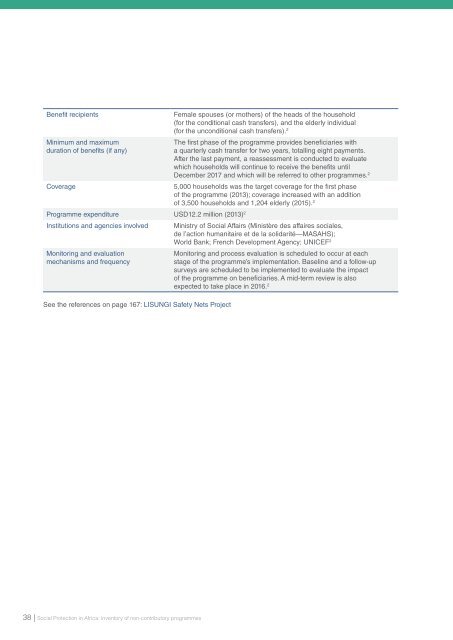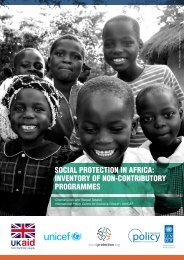https://goo.gl/sZ7V7x
293g79C
293g79C
Create successful ePaper yourself
Turn your PDF publications into a flip-book with our unique Google optimized e-Paper software.
Benefit recipients<br />
Minimum and maximum<br />
duration of benefits (if any)<br />
Coverage<br />
Female spouses (or mothers) of the heads of the household<br />
(for the conditional cash transfers), and the elderly individual<br />
(for the unconditional cash transfers). 2<br />
The first phase of the programme provides beneficiaries with<br />
a quarterly cash transfer for two years, totalling eight payments.<br />
After the last payment, a reassessment is conducted to evaluate<br />
which households will continue to receive the benefits until<br />
December 2017 and which will be referred to other programmes. 2<br />
5,000 households was the target coverage for the first phase<br />
of the programme (2013); coverage increased with an addition<br />
of 3,500 households and 1,204 elderly (2015). 2<br />
Programme expenditure USD12.2 million (2013) 2<br />
Institutions and agencies involved Ministry of Social Affairs (Ministère des affaires sociales,<br />
de l’action humanitaire et de la solidarité—MASAHS);<br />
World Bank; French Development Agency; UNICEF 2<br />
Monitoring and evaluation<br />
mechanisms and frequency<br />
See the references on page 167: LISUNGI Safety Nets Project<br />
Monitoring and process evaluation is scheduled to occur at each<br />
stage of the programme’s implementation. Baseline and a follow-up<br />
surveys are scheduled to be implemented to evaluate the impact<br />
of the programme on beneficiaries. A mid-term review is also<br />
expected to take place in 2016. 2<br />
38 | Social Protection in Africa: inventory of non-contributory programmes



